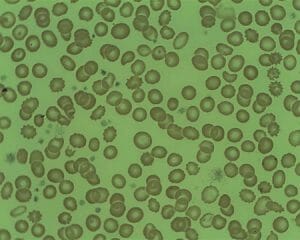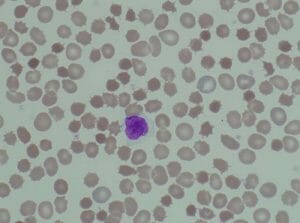Crenation Definition
In botany and zoology, crenation refers to the leaf-like scalloped edges of an object such as a leaf or a shell. In biology, crenation describes the formation of abnormal notched surfaces on cells as a result of water loss through osmosis.
Cells are usually in an isotonic solution inside the body, meaning that there is the same concentration of solute and water both inside and outside the cells. This equilibrium allows the cells to keep their shape, with water moving in and out at a constant rate and maintaining the same osmotic pressure across the semipermeable membrane. However, when this equilibrium is disrupted by the presence of a higher concentration of solute in the solution, it creates a hypertonic environment, which causes the intracellular water to diffuse out. The cells start to shrivel and form abnormal spikes and notches on the cell membrane. This process is called crenation.
Examples of Crenation
Red Blood Cell Crenation
Red blood cells are prone to undergoing crenation as either a response to ionic changes in the blood or abnormalities in the cell membrane, disrupting the cell’s ability to maintain an isotonic state. There are two different types of crenated red blood cells: echinocytes and acanthocytes. Instead of the usual rounded biconcave shape, both these cells appear with a rounder form and spiny projections on the cell surface.
In echinocytes, the spines are short, uniform and regularly spaced. Even though they possess adequate amounts of hemoglobin for survival, their occurrence suggests an underlying disease is present. This type of crenation is usually reversible and can be caused by either ionic imbalances, such as the presence of high pH or high calcium concentrations, or by diseases such as uremia or pyruvate kinase deficiency, which results in cellular loss of potassium and water. It could also be a side effect from the consumption of certain drugs or chemotherapy agents.
The photograph below shows the presence of echinocytes amongst healthy red blood cells:
Acanthocytes possess spines on the cell membrane that manifest in uneven and abnormal distributions, numbers and lengths. The irregular morphology is caused by alterations in the membrane lipids as a result of diseases such as abetalipoproteinemia, which causes abnormal lipid concentrations within the blood as well as the inability to make certain lipoproteins vital for cell membranes. Other diseases such as vitamin E deficiency, liver disease or malabsorption may also have the same effect. This type of crenation is irreversible.
The morphology of acanthocytes is shown below:
Food Pickling
Food pickling is another example of crenation occurring in every day life. Vegetables such as cucumbers are placed in acidic solutions to pickle, causing water to diffuse out and the characteristic shrinkage of the crenation process.
Related Biology Terms
- Diffusion – the passive movement of molecules as a result of concentration gradients.
- Osmosis – the diffusion of solvents from areas of high concentration to areas of low concentrations through a semi-permeable membrane.
- Isotonic – a solution that has the same intracellular and extracellular solute concentration, resulting in an equilibrium where water can flow freely through a semi-permeable membrane without changing any concentration levels.
- Hypertonic – a solution that has higher extracellular solute concentration.
Quiz
1. A red blood cell is placed into different solutions. Which scenario will likely result in crenation?
A. Placed in an isotonic solution
B. Placed in a solution with a very high concentration of solute
C. Placed in a solution with a very low concentration of solute
D. None of the above
2. Reversible crenation and uniform spikes on red blood cells are characteristic of which type of cells?
A. Erythrocytes
B. Acanthocytes
C. Echinocytes
D. None of the above
3. Which of the following diseases does not cause the formation of acanthocytes?
A. Liver disease
B. Pyruvate kinase deficiency
C. Abetalipoproteinemia
D. Vitamin E deficiency


